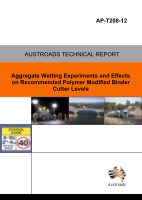Pavement

- Publication no: AP-T208-12
- ISBN: 978-1-921991-45-5
- Published: 12 September 2012
- PDF (free) Download
The work described in this report determines updated cutter level recommendations for S10E and S20E binders. Studies were also conducted to investigate the relationship between the contact angle of water on films of bitumen and PMB binders, and aggregate wetting behaviour. Preliminary studies also investigated the wetting behaviour of a cationic rapid setting (CRS) emulsion on basalt aggregate.
Investigations to determine updated cutter levels for S10E and S20E binders initially involved conducting a series of wetting experiments where the degree of binder coating of Class 170 (C170) bitumen, S10E and S20E binders (and blends of these materials with different amounts of cutter) was visually assessed after binder films and basalt aggregate had been in contact for 20 hours.
- 1. INTRODUCTION
- 2. EXPERIMENTAL DESIGN
- 2.1. Materials and Dynamic Shear Rheometer Experiments
- 2.2. Methods
- 2.2.1. Preparation of Binder/Cutter Blends
- 2.2.2. Preparation of Bitumen and PMB Binder Films for Aggregate Wetting Tests
- 2.2.3. Preparation of CRS Emulsion Films for Aggregate Wetting Tests
- 2.2.4. Aggregate Wetting Tests
- 2.2.5. Water Contact Angle Measurements on C170 Bitumen and PMB Binders
- 3. RESULTS AND DISCUSSION
- 3.1. Aggregate Wetting Tests with Class 170 Bitumen and PMB Containing Binders
- 3.2. Preliminary Aggregate Wetting Tests on a CRS Emulsion
- 3.3. Calculation of Recommended Cutter Levels
- 3.3.1. Calculation of Recommended Cutter Levels Using the Experimental Method of Maccarrone
- 3.3.2. Determination of Recommended Cutter Levels for S10E and S20E Binders Using an Alternative Method
- 3.3.3. Summary of Recommended Cutter Level Calculations
- 3.4. Water Contact Angle Measurements on C170 Bitumen and PMB Binders
- 4. CONCLUSIONS
- REFERENCES
